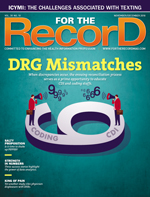November/December  2018
2018
Editor's Note: Simplified E/M Documentation
By Lee DeOrio
For The Record
Vol. 30 No. 10 P. 3
Here's a loaded question: How often do you believe government officials listen to the concerns of their constituents? It's aggravating and upsetting when government officials give lip service to legitimate dissenting viewpoints. Many citizens have become so jaded by the inattention that they've given up the fight, electing instead to mock anyone who attempts to partake in such futility.
Fortunately, that's not always the case. You can argue that physicians are hardly the poster children for the oppressed but nevertheless they did manage to have their voices heard following the July release of the proposed Medicare Physician Fee Schedule and the Quality Payment Program rule by the Centers for Medicare & Medicaid Services (CMS).
Doctors took to the internet to register their complaints with what they considered to be onerous demands. The result was a final rule, released November 1, that better reflected their needs and wishes.
Over the summer, CMS had proposed decreasing the number of evaluation and management (E/M) codes from five levels to two, which likely would have resulted in reduced payments for treating complex patients. That proposal has been tabled for two years, allowing industry stakeholders time to analyze the issue and offer solutions. CMS also declined to move forward on a proposal to reduce payment for office visits when performed on the same day as another service.
With the rule, CMS is attempting to simplify physician E/M documentation in advance of the 2021 coding and payment changes, according to Stanley Nachimson, principal of Nachimson Advisors. The changes, which take effect January 1, 2019, include the following:
• when relevant information is already contained in the medical record, practitioners may choose to focus their documentation on what has changed since the last visit or on pertinent items that have not changed. They do not have to rerecord the defined list of required elements if there is evidence that the practitioner reviewed the previous information and updated it as needed.
• The requirement to document the medical necessity of a home visit in lieu of an office visit is eliminated.
• For new and established patients, practitioners need not reenter the patient's chief complaint and history that was already entered by ancillary staff or the beneficiary. The practitioner may simply indicate in the medical record that he or she reviewed and verified this information.
Once the changes in coding and payment are implemented, CMS is permitting practitioners to choose to document E/M office/outpatient level 2 through 5 visits using medical decision-making or time instead of applying the current 1995 or 1997 guidelines.
"CMS believes that this will save practitioners time and allow them to concentrate more on patient care than documentation," Nachimson says. "This also can be seen as attempting to soften the blow of the E/M coding changes, which may result in some reduction in payments to practitioners whose visits tend to be more level 4 than level 2."



